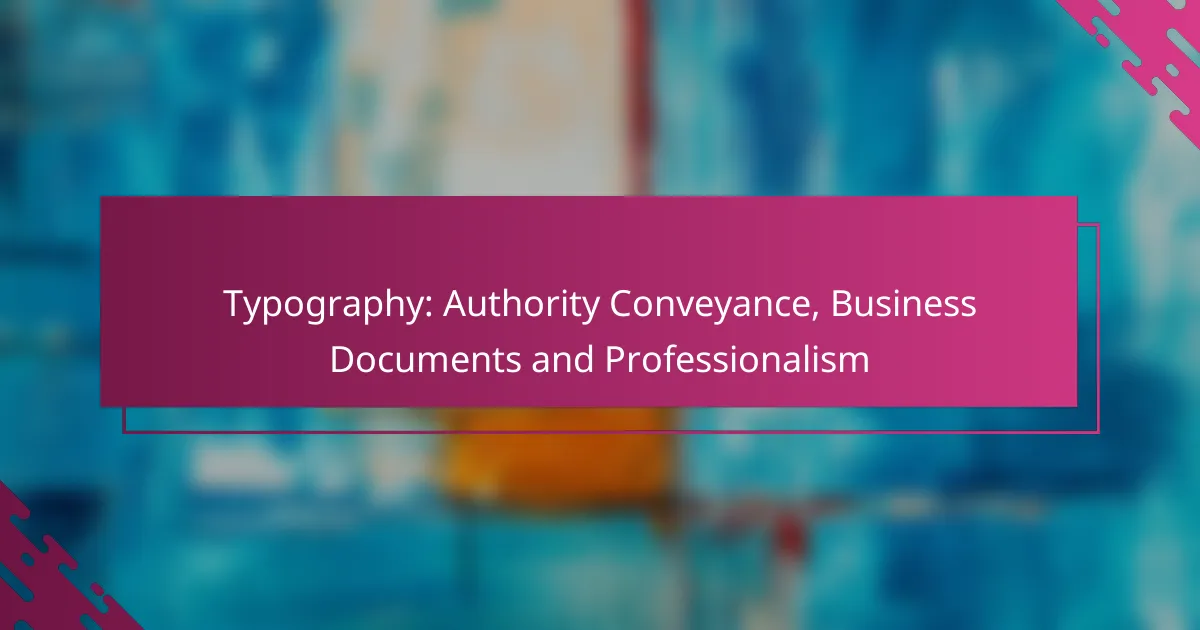Typography is a vital element in business documents, as it establishes authority and enhances readability, directly influencing how information is perceived by the reader. The careful selection of fonts, sizes, and colors not only contributes to the professionalism of a document but also fosters trust and credibility. By implementing effective typography practices, organizations can reinforce their brand identity and communicate their values more clearly.
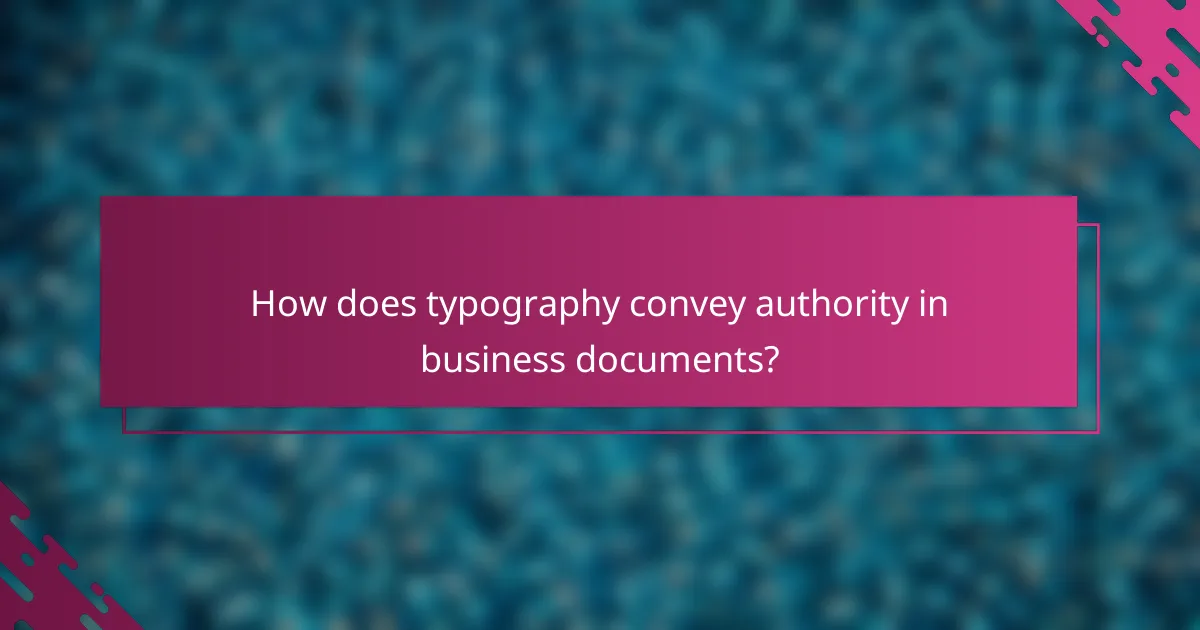
How does typography convey authority in business documents?
Typography conveys authority in business documents by establishing a visual hierarchy and enhancing readability, which influences how information is perceived. The choice of fonts, sizes, and colors can significantly impact a document’s professionalism and the trust it instills in the reader.
Use of serif fonts for professionalism
Serif fonts, characterized by their small decorative lines at the ends of letters, are often associated with tradition and reliability. They are frequently used in formal documents, such as reports and contracts, as they enhance readability and convey a sense of authority. Examples of popular serif fonts include Times New Roman and Georgia.
When selecting a serif font, consider using sizes between 10 and 12 points for body text to ensure clarity. Avoid overly stylized serif fonts that may distract from the content, as simplicity often reinforces professionalism.
Impact of font size on readability
Font size plays a crucial role in the readability of business documents. Generally, sizes between 11 and 12 points for body text are recommended, while headings can vary from 14 to 18 points depending on the hierarchy. Larger font sizes improve legibility, especially for readers with visual impairments.
Be cautious with font sizes that are too small, as they can lead to frustration and misinterpretation of information. Always ensure that there is sufficient contrast between the font color and the background to enhance readability.
Color psychology in typography
The colors used in typography can evoke specific emotions and perceptions, influencing how authority is conveyed in business documents. For instance, blue is often associated with trust and professionalism, making it a popular choice for corporate branding. In contrast, red can evoke urgency or passion but may be perceived as aggressive if overused.
When selecting colors, aim for a palette that complements your brand while maintaining readability. Use darker colors for text against lighter backgrounds to ensure clarity and avoid overwhelming the reader with too many colors, which can dilute the document’s authority.
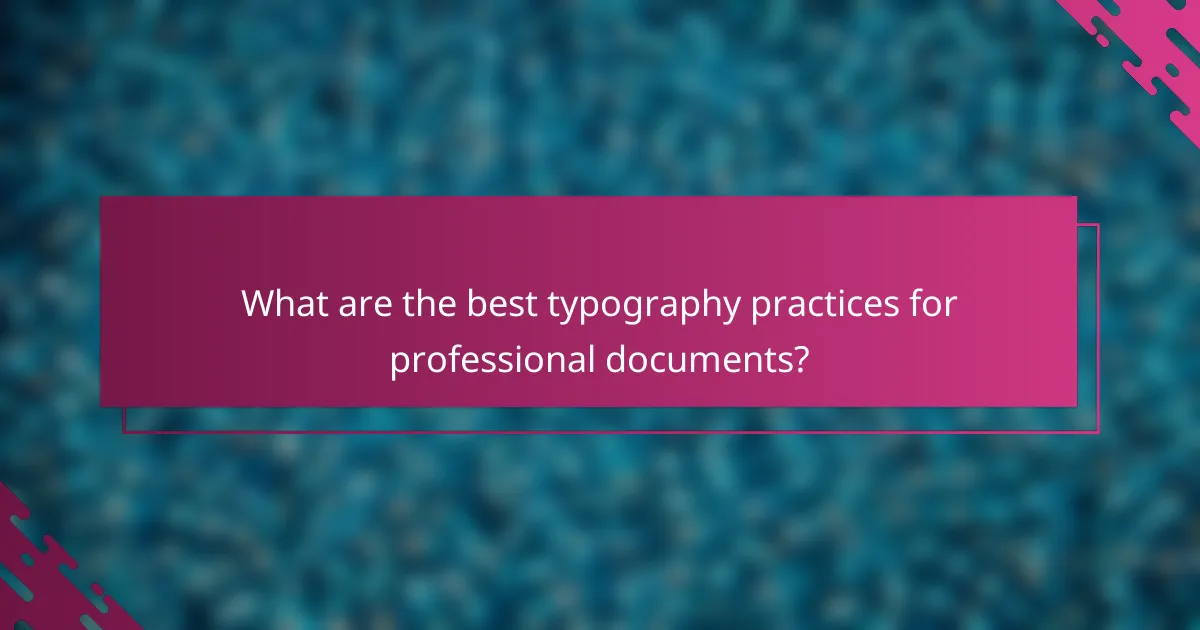
What are the best typography practices for professional documents?
Effective typography in professional documents enhances readability and conveys authority. Key practices include selecting appropriate font families, maintaining consistent styles, and utilizing white space effectively.
Choosing the right font family
Selecting the right font family is crucial for establishing a professional tone. Sans-serif fonts like Arial or Helvetica are often preferred for digital documents due to their clean appearance, while serif fonts like Times New Roman or Georgia can lend a more formal feel to printed materials.
Consider the context of your document when choosing a font. For instance, business proposals may benefit from a more traditional serif font, while marketing materials might be better suited to modern sans-serif options. Aim for a font size between 10 and 12 points for body text to ensure readability.
Maintaining consistent font styles
Consistency in font styles across a document reinforces professionalism and coherence. Use a limited number of font families—ideally one for headings and another for body text—to avoid visual clutter.
Establish a hierarchy with font weights and sizes. For example, use bold for headings and regular for body text, ensuring that headings are noticeably larger. A common practice is to use a larger font size for headings, typically 14 to 18 points, compared to body text.
Importance of white space
White space, or negative space, is essential for enhancing readability and focus in professional documents. It helps to separate different sections, making the content easier to digest.
Incorporate adequate margins and spacing between paragraphs and sections. A good rule of thumb is to use at least 1.5 line spacing for body text. Avoid overcrowding your document with text; instead, aim for a balanced layout that guides the reader’s eye smoothly through the content.

How can typography enhance brand identity?
Typography plays a crucial role in enhancing brand identity by establishing a visual language that reflects a company’s values and personality. Thoughtful font choices can evoke emotions, create recognition, and differentiate a brand in a crowded market.
Custom typefaces for unique branding
Custom typefaces can significantly strengthen brand identity by providing a distinctive look that sets a business apart. Brands like Coca-Cola and Google have developed unique typefaces that are instantly recognizable and convey their brand essence.
When considering a custom typeface, ensure it aligns with your brand’s voice and target audience. A playful font may suit a children’s toy company, while a sleek, modern typeface might be better for a tech startup.
Typography in logos and marketing materials
Typography in logos and marketing materials is essential for creating a cohesive brand image. The font used in a logo should be legible and reflect the brand’s personality, whether it’s formal, casual, or innovative.
In marketing materials, consistent typography helps reinforce brand recognition. Use the same fonts across all platforms, including websites, brochures, and social media, to create a unified appearance. Avoid using too many different fonts, as this can dilute your brand’s identity.
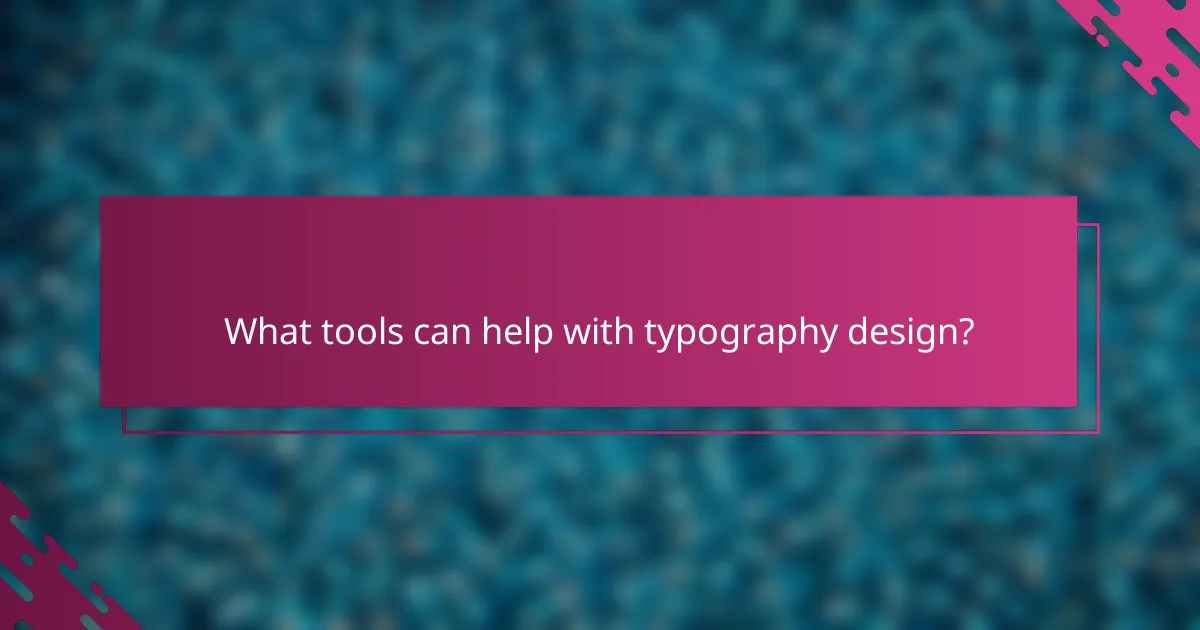
What tools can help with typography design?
Several tools can enhance typography design, ensuring that your business documents convey professionalism and authority. Key options include Adobe Fonts, Canva, and Google Fonts, each offering unique features suited for various design needs.
Adobe Fonts for diverse options
Adobe Fonts provides a vast library of typefaces that can elevate your typography design. With thousands of fonts available, users can easily find styles that align with their brand identity and project requirements.
When using Adobe Fonts, consider the licensing terms, as fonts are typically included with Adobe Creative Cloud subscriptions. This makes it a cost-effective choice for businesses already utilizing Adobe products.
Canva for easy document creation
Canva is a user-friendly design platform that simplifies document creation, including typography design. Its drag-and-drop interface allows users to experiment with various fonts and layouts without needing extensive design skills.
Canva offers a selection of free and premium fonts, making it accessible for different budgets. However, ensure that the fonts you choose align with your branding and are legible for your target audience.
Google Fonts for web accessibility
Google Fonts is an excellent resource for web typography, providing a wide range of free fonts optimized for online use. This platform ensures that your text remains readable across different devices and screen sizes.
When selecting fonts from Google Fonts, consider the loading speed and compatibility with your website. Using web-safe fonts can enhance user experience and maintain professional appearance across various browsers.
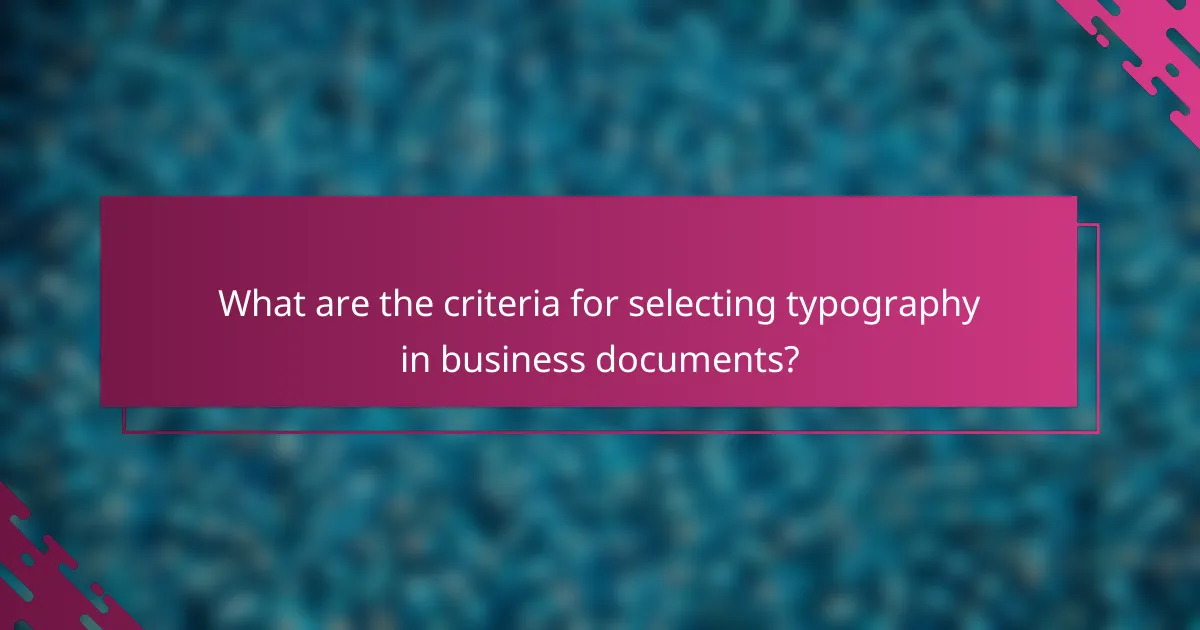
What are the criteria for selecting typography in business documents?
Selecting typography for business documents involves ensuring clarity, professionalism, and alignment with brand identity. Key criteria include readability, legibility, and how well the chosen fonts reflect the company’s values and mission.
Readability and legibility standards
Readability refers to how easily text can be understood, while legibility focuses on how easily individual characters can be distinguished. When selecting typography, opt for fonts that are clear at various sizes and formats, typically sans-serif fonts for digital documents and serif fonts for printed materials.
Consider using a font size of at least 10-12 points for body text to enhance readability. Additionally, maintain adequate line spacing (1.5 to 2 times the font size) and contrast between text and background to improve legibility.
Alignment with company values
The typography you choose should reflect your company’s brand identity and values. For instance, a tech startup might opt for modern, clean fonts to convey innovation, while a law firm may choose traditional serif fonts to project authority and trustworthiness.
When selecting typography, consider the emotional response you want to evoke. Conducting surveys or focus groups can help determine which fonts resonate best with your target audience and align with your brand’s mission.
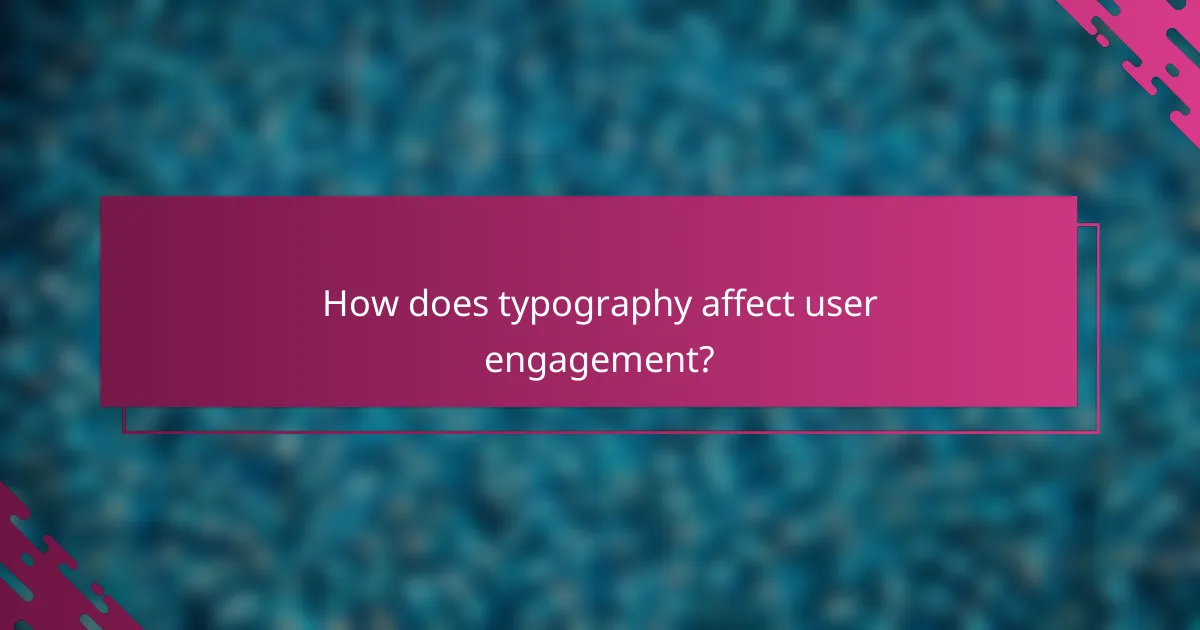
How does typography affect user engagement?
Typography significantly influences user engagement by shaping how information is perceived and understood. Effective typography can enhance readability, draw attention, and create a sense of professionalism, which keeps users interested and encourages interaction.
Impact on first impressions
The first impression of any document or website is often determined by its typography. A clean, well-structured typeface can convey professionalism and credibility, while poor typography may lead to a negative perception. For instance, using a modern sans-serif font can create a fresh and approachable feel, while a serif font can evoke tradition and reliability.
Consider the context of your audience when selecting typography. For business documents, a classic font like Times New Roman or Arial can establish authority, whereas creative industries might benefit from more unique typefaces. Always ensure that the font size and spacing are adequate to avoid overwhelming the reader.
Influence on information retention
Typography plays a crucial role in how well users retain information. Research indicates that well-chosen fonts and clear layouts can enhance memory recall by making content easier to digest. For example, using larger font sizes for headings and subheadings helps to organize information hierarchically, allowing readers to navigate content more effectively.
To improve retention, use a combination of font styles, such as bold for emphasis and italics for quotes or important terms. Avoid overly decorative fonts that may distract from the message. Aim for a balance between aesthetics and clarity to ensure that the information is not only engaging but also memorable.
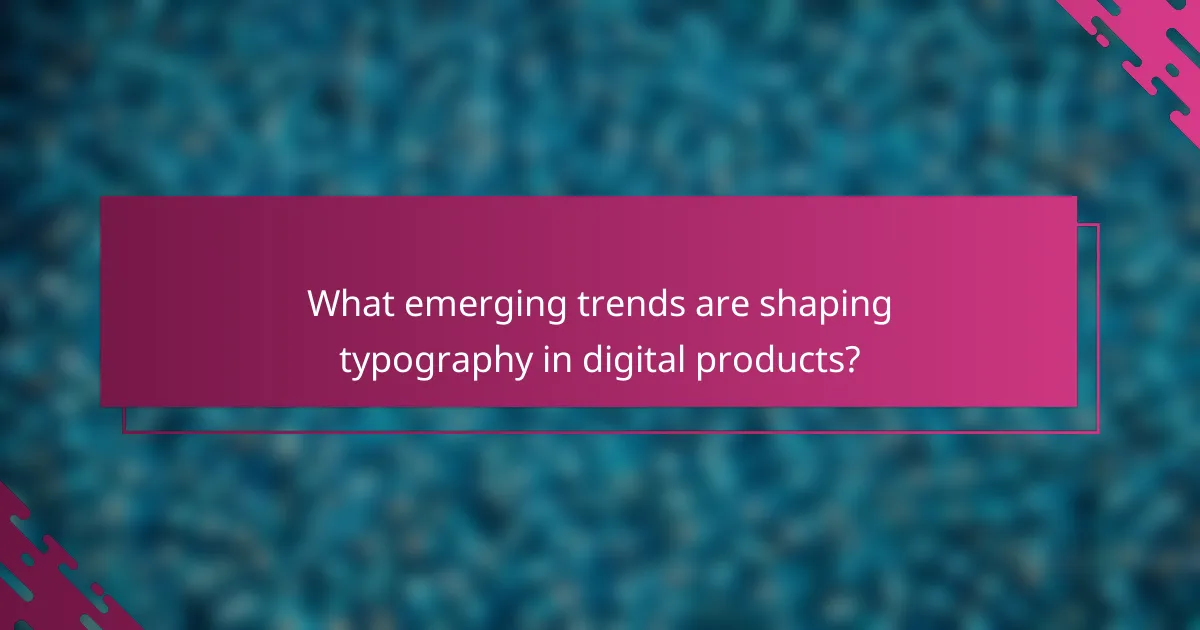
What emerging trends are shaping typography in digital products?
Emerging trends in typography are increasingly focused on enhancing user experience and accessibility in digital products. Key developments include the use of variable fonts and the integration of typography with AI tools, which allow for more adaptive and personalized design solutions.
Variable fonts for responsive design
Variable fonts are a single font file that contains multiple styles, weights, and widths, allowing designers to create responsive typography that adapts to different screen sizes and resolutions. This flexibility reduces load times and improves performance, making them ideal for modern web applications.
When implementing variable fonts, consider the range of styles you need. For instance, a font that offers a range from thin to bold can provide visual hierarchy without requiring multiple font files. This can streamline your design process and enhance user engagement.
Integration of typography with AI tools
The integration of typography with AI tools is transforming how designers approach text layout and style. AI can analyze user behavior and preferences to suggest optimal font choices and sizes, ensuring that typography enhances readability and user interaction.
Using AI-driven typography tools can help streamline design workflows. For example, platforms like Adobe Fonts and Google Fonts now offer AI features that recommend font pairings based on the content type and audience. However, it’s essential to maintain a balance between automation and human creativity to ensure that the final design aligns with brand identity.
